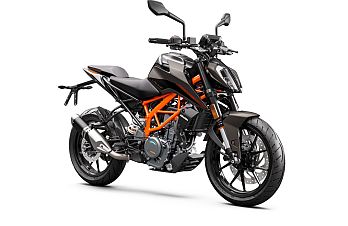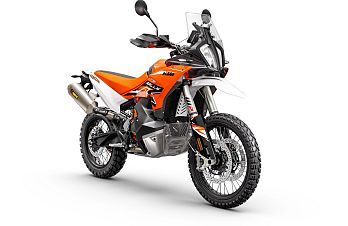The march of motorcycle design technology has long been both a driver of innovation and a reflection of it. By that I mean advancements unique to motorcycle design have kept the motorcycle industry in near-constant forward motion, but adaptations of new and existing technologies alike from other industries have also powered motorcycle design itself forward.
This is an exciting time to be a motorcyclist because now, more than ever, it's electronics that are revolutionizing motorcycle technology.
Advanced electronic applications are not only making engine performance more potent and efficient—electronic wizardry is making some of the most powerful production motorcycles ever built. Bikes are now more stable, manageable and user-friendly, making them safer than ever before.
For example,the new Yamaha YZF-R1 and YZF-R1M models employ advanced electronics in nearly every operating system on the bike. The now-familiar ride-by-wire throttle is just the beginning. Linked ABS brakes, electronic racing suspension (by Ohlins on the R1M), a six-axis inertial measurement unit that feeds data to a 32 bit central processing unit to—in turn—operate the traction control, slide control, ABS brakes and wheelie control system. An electronic launch control system (are we talking Atlas rocket here?), and the adjustable wheelie control system help keep the bike straight and level while maximizing forward thrust.
On the R1M, GPS technology helps map out improved lap times by tracking vital functions like bike lean angle, engine and transmission parameters, and other data to allow minute details of every lap on the track to be analyzed. Of course, yet more electronics in the engine control unit for fuel and ignition system management are brought to bear. Still more electronics stare you in the face from the all-digital LCD instrument panel.
You may ask, "Is all this really necessary on any production motorcycle? Well, consider the alternative of turning a 197 hp motorcycle loose on the riding public without all of it. Making a bike that is both powerful and controllable is an obligation Yamaha has thought about.
Engine technology continues to move ahead as well. With the introduction of its Ninja H2 and H2R models, Kawasaki has introduced a new way to push the horsepower envelope. The H2R is the track-only version of the H2, which comes with a supercharged 998cc in-line four cylinder engine. Supercharging a motorcycle engine is not new; BMW had supercharged road racers back in the 1930s. However, supercharging a street-legal bike with an integral supercharger capable of producing nearly 300 hp is brand new.
Existing supercharger equipment out on the market would not work due to heat management issues, so Kawasaki went to its in-house branch that works with such equipment for a solution—and the result is what makes the H2’s jaw-dropping horsepower possible. An all-new purpose-built blower provides nearly 40 psi boost and spins at up to 140,000 rpm (that’s 2,333 spins per second!) all without inter-cooling.
The H2 takes potential top speed from a production motorcycle to new extremes—over 250 mph could be reached according to some estimates. Chances are that another summer will not go by without that being put to the test on the salt flats at Bonneville. That kind of speed in itself presents some potential problems and challenges, and Kawasaki also has rolled out a slew of technological responses.
Aerodynamics were given greater emphasis than ever simply because at speeds like that, cutting through the air has a profound effect on stability and handling; down force really matters. The H2R version comes with forward-mounted air foils to help produce that down force.
The H2 engine is full of forward-leaning—different-than-anything else—simply because supercharging changes so many things in the way the engine operates. For example, the compression ratio is relatively low at 8.5:1. Counter-intuitive for a massively powerful engine, no?
Electronics to detect and prevent pre-ignition of the fuel charge are present to protect the engine internals from being hammered to death. As with the Yamaha R1, Kawasaki employs its own electronics for ABS, traction control, launch control and engine-braking boost. There's whiz-bang technology to make the most powerful production motorcycle in the world rideable—or at least as rideable as such a bike can be.
The secret of all these systems is really pretty simple: data processing. These systems have microprocessors that can handle thousands of sensor inputs simultaneously in seconds and make adjustments to operating parameters hundreds of times a second, sensing and preventing the skid, wheel lock, wheelie or wheelspin before it happens.
On other fronts, the very essence of what defines a motorcycle is evolving as EV (electric vehicle) development in the motorcycle market surges forward.
Harley-Davidson’s shocking (pardon the pun) roll-out of its Project Livewire electric bike has the industry buzzing like a transformer about to melt down. Project Livewire turns the age-old knock on the Motor Company for being too stogy and resistant to change on its head and proves that H-D is looking ahead, not over its shoulder. Your grandchild’s Harley may launch with a turbine-like whir instead of a potato-potato-potato rumble.
Polaris taking on the assets of Brammo—one of the leading e-bike manufacturers—is another signal that e-bikes are here to stay. Polaris’s huge marketing, manufacturing and engineering muscle applied to the e-bike product line is likely to propel it to new levels of performance, range and market penetration. If the way Polaris developed and elevated the Indian and Victory product lines is any indication, the e-bike market may be in for a paradigm shift.
California’s Zero Motorcycles is not only advancing the art of electric propulsion with extended range capabilities on its 2015 bikes, it's also broadening its electronics portfolio with the addition of Bosch anti-lock brakes.
Bosch is the same firm offering a new motorcycle stability control system (MSC). MSC was first launched in 2013 on KTM’s 1190 Adventure models. In September 2014, KTM announced it will install the system on its new 2015 1290 Super Adventure.
The MSC system, based on the Bosch anti-lock braking system (ABS), uses a lean angle sensor that constantly measures wheel speed, yaw rate, lean angle, and pitch angle to modulate braking and acceleration to optimize safety in difficult maneuvers and cornering. The system applies acceleration and braking proportionally to prevent the wheels from locking, spinning, or lifting and monitors riding dynamics to achieve maximum deceleration in straight-line braking.
About the only thing that hasn’t been attempted is a motorcycle that can stand up by itself. Oh, wait a minute—it has been done and may be coming soon to a road near you.
Lit Motors C-1 combines EV technology with the same kind of gyroscopic stability control used in guided missiles to make the self-balancing motorcycle a reality. A fully enclosed streamlined body is thus possible for the motorcycle riding experience combined with the all-weather comforts of a car. What’ll they think of next?
Of course, no amount of microprocessor power or gyroscopic stabilization can prevent every crash like the moron who cuts across in front of you or runs a red light. To answer the call for those situations, in 2007, Honda released a front impact air bag system for the Gold Wing and Dainese and others are advancing the design of armored riding gear, helmets, and even leathers with built-in airbags such as the Dainese D-Air suit.
In the sixties when Honda and other manufacturers began pushing the boundaries of motorcycle design and performance with four, five and six cylinder GP racing bikes, the course was laid that led to the street multi-cylinder superbikes of the seventies and eighties. The advancements that made GP bikes ever faster and more reliable translated into new technology for consumers. Similarly, track-born advancements of today are moving to the consumer market faster than ever before.
The electronic revolution sweeping the motorcycle industry today is something like that and unless I miss my guess, the results will be even more amazing. Hang on to your handlebars...it’s going to be a wild, but safer, ride!


















24
Comment